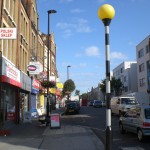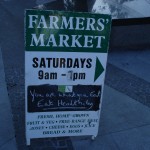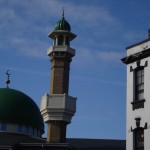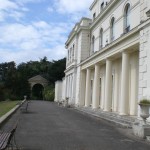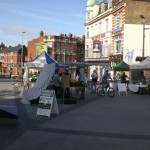Entries Tagged as 'Jeyla'
Tourist-a person who travels for pleasure or culture, usually sightseeing and staying in hotels (Webster Dictionary).
Tourism. I am a tourist. A tourist in England, specifically in London.
For the past two weeks it has been an interesting feeling to be identified as a tourist, especially because I have never had an experience or ever held a title of “a tourist.” And upon arriving to London and feeling comfortable in this big city, I felt like I was exploring a borough in New York City. Tourism. Although throughout time people like to shed the idea and a title of being a TOURIST I, on the contrary, have been acknowledging and embracing my expedition. Let me explain…
My journey towards loving being a tourist began upon our entrance to the Westminster Abbey. The fact that I felt like a tourist might have been due to all of the other tourists surrounding me, gazing at all of the famous philosophers, artists, writers, politicians laying in their tombs beneath our feet. This visit has definitely imprinted itself in my mind. When again will I be able to stand close to Isaac Newton, Charles Dickens, T.S. Eliot, Elizabeth I, Charles Darwin and many others who have had made such amazing impacts on OUR civilization and MY world today. I wonder what other “tourists” felt when they were taking each step across the tombs. Whether they have realized how much history existed in one structure.
Tourism. I am exploring another culture, visiting exhibitions, museums and parks that are only accessible to me on this visit to London. I am amazed.
Visiting the National Gallery was another experience where my temptation to touch the art work of Leonardo Da Vinci, Claude Monet and Van Gogh reminded me of my “touristy” ways. As I stood close to pieces of never repeated art I was staring my privilege right into the eyes . I am one of the lucky ones who gets to witness such creations. Discussing our visit to the National Gallery, my friends and I were speechless and grateful. Knowing that I was the only one in my family who actually had a privilege of not only traveling to England but also visiting museums such as National Gallery for free is indescribable. But once again I was wondering what everyone else was thinking who surrounded me? Did they realize where they were and what they were witnessing? I guess I will never know but being a privileged tourist that I am I made sure to take it all in. To completely immerse myself in art, in Da Vinci, Monet, Van Gogh, and Van Dyke. Wishing that I could feel the art with my fingertips in order to make sure it is real.
Visiting the backstage of National Theater yesterday, I came to a realization that for our continuous stay in London, I will remain a tourist. I am a person who is staying in a hotel exploring culture and my surroundings. Not only am I astonished by the things I am allowed to view but I am trying to take as much as I can in. National Theater has left me speechless, with a view of what goes on backstage, the props used, the spaces that surrender the actors when they are not on stage, the testing of the lights and music. Once again I am ecstatic to be a traveler, a tourist, an individual who is allowed to invade spaces that most do not get to see. As long as we continue to explore, I will continue to call myself a “tourist” and loving every moment.
Tags: Jeyla · Museums · Theatre
August 31st, 2009 · 1 Comment
Imagine being in a place where all of your passions interconnect, where your heart races, you forget to breathe, your interest peaks. I have to remind myself to breathe today upon entering The Victoria and Albert Museum directly from stepping off the tube station into the museum. Deep breaths, I say to myself when I see Louis Richard Garbe’s piece, Primavera. Deep breaths I tell myself when I see the dresses by Catherine Walker worn by Princess Diana. Deep breaths when I stumble upon Joan Rhodes’s theatrical costumes, Reg Wilson’s performance photographs, sight of jewelry worn throughout centuries, breath taking carpets and other Islamic crafts. Inspiration surrounds me everywhere.
“Sculpture is a three-dimensional object with a message…”
Bob Brendle
After examining the sculptures showed at The Victoria and Albert Museum, I felt the messages sculptures were illuminating. A child and a mother, the look they share, the connection and love that exists between them. A cupid slyly planning his next attack, by preparing a bow and arrow to shoot at a King. Two soldiers fighting, the anger and determination in their stony eyes. Moving on to Islamic carpets, I am reminded of my own culture, of beautifully woven rugs and elaborately decorated vases. Not having a map at hand, I began walking through the museum, stumbling upon the silver lined plates and crafts of Paul de Lamerie and the portion of the museum which holds theatre exhibitions. Ranging from costumes worn by Joan Rhodes to the construction of the stage and backstage look at the performances in 18th Century, I was pleasantly surprised. Although the museum provided satisfaction to all of my senses, I was on the quest to finding two of my upmost passions, photography and jewelry. As I finally stepped through the doors of jewelry exhibit, I was blinded by diamonds, gold, silver, crowns, pendents. I thought “This is what heaven must look like” (at least in my world). Behind glass windows, jewels worn in 1500’s lined against the walls ranged to the present trends in jewelry. Inspiration surrounding me everywhere, I headed towards the photography section. As I entered, I was overpowered by Charles de Temple, E.R. Nele, Roger Moris and many more. The museum began acquiring pieces in 1852 and now I was in the presence of classic as well as contemporary works. One piece that particularly caught my attention was of a “Shell-shocked Soldier, Hue” by Don McCullin in 1968 taken during the Vietnam War. The simplicity yet so much emotion behind the piece and the soldier’s eyes is indescribable. My passion has ignited. Although I have always captured my surroundings and emotions through a camera lens, seeing the photography exhibit has encouraged me and made me hope that one day I can also show my work. Who knows what holds in the future for me and my photography. But for now I am planning on returning to The Victoria and Albert Museum and exploring other photography exhibitions in London such as Tom Hunter’s “A Journey Back” shown close by on Oxford Street.
I am inspired. 
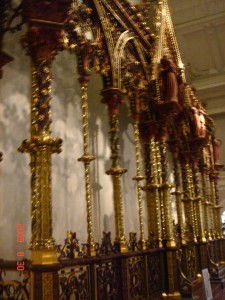
Tags: Jeyla · Museums
As we all stop by the World War II memorial to capture the moment of our presence at this landmark, I notice a memorial representing women who served in World War II and can not help but to think “Finally! A monument to show dedication of and to women.” This thought crosses my mind because although England had many women in power and on throne, I have not seen many acknowledgments in our weeks of travel. This has led me to take numerous photos of the monument as well as complete more research.
Being in a country where white male domination occurred for centuries and being a Women’s and Gender Studies major I could not be more proud to have a bronze sculpture situated in Whitehall, London located in Parliament Square. It was unveiled on July 9th, 2005 by Queen Elizabeth II and was named National Monument to the Women of World War II. It was sculpted by John W. Mills and it stands at 22 feet high, 16 feet long, and 6 feet wide. The sculpture itself includes many details that one would not notice unless they move closer to the monument to observe it. There is lettering on the sides which replicates the typeface used on war time ration books. Also there are seventeen individual sets of clothing and uniforms depicting the ones worn at war and the jobs which women held throughout the years. Baroness Boothroyd, Former Speaker of the House of Commons and a person responsible for raising the funds for the monument stated:
“I hope that future generations who pass this way down Whitehall will ask themselves what sort of women were they and look at history for the answer.”
With a lot of positive responses regarding the dedication, there also came many negative comments. Many were outraged because the monument is dedicated specifically to women while there is no monument in existence dedicated to the men who served in the World Wars. Another interesting debate that occurred was regarding the patriarchal constructs and how sacrifices and male contributions to the war are automatically acknowledged over the women’s contributions. Therefore, a memorial dedicated specifically to women were constructed in order to remind those who pass down Whitehall.
While reviewing the comments expressed by the British public, I am debating on how I feel about the monument. But I do have to say that no matter what the reasons were for the British government constructing this piece of art, I am happy. I do believe that there needs to be a reminder, especially in an area such as the Parliament Square, that women played a large part in not only supporting men but also taking over jobs that were required for survival men, women and children. I would love to know what everyone thinks about the Monument. Whether it should be in existence, whether anyone else felt how big of a part it played in the Square, and whether it is fair to the men who served during the War.
Tags: Jeyla
August 26th, 2009 · 1 Comment

After spending our morning at Westminster Abbey we decided to head to the Tower of London… but needed to get some lunch first. We stopped at a small Italian restaurant and were immediately attended to by a petite, efficient waitress who moved at an abrupt pace and appeared to serve ten tables at a time. She rushed us into ordering food and drinks while ending each sentence in “Please, thank you.” To make our long story short, by the end of our quick yet delicious meal we were stressed to the point of no return. Attempting to escape our stressful waitress we headed to the Waterloo tube Station.
We took the train that lead us to the London Bridge stop instead of Tower Hill Station, a simple mistake on our part. Leaving the station, we walked through the “Queen’s Walk” and came upon the HMS Belfast Battleship, immediately we thought this would be an interesting excursion. Having just an audio guide and our digital cameras we proceeded to board the ship and explore this historical landmark. On our self-guided tour we struggled as we made our way through narrow stairs, pipe filled boiler rooms and the inescapable smell of gun powder in the weapon filled rooms.
We learned that the ship is part of the Imperial War Museum and was first launched on St Patrick’s Day of 1938; it played a vital role in the Second World War. During our tour we discovered that Belfast was the leader behind the destruction of the German battlecruiserScharnhorst during the Battle of North Cape.
Although, as a collective we are promoters of peace, we couldn’t help but to be impressed by the ship’s weaponry infrastructure. There were two identical shell rooms with machines that were capable of launching eight shells per minute which led Jack Frost (crew member of HMS Belfast) to describe the ship as a “floating gun plot.” Members of the crew had specific job titles ranging from weapon handling, chefs, dentists, and even surgeons! We had fun interacting with the wax figures which were placed throughout the ship to represent actual crew members. After attempting to climb out of the lower chambers of the ship, we were happy to inhale fresh air.
We took a short break, and headed towards the Tower Bridge. We crossed the bridge and felt a sense of accomplishment as this is one of the most famous bridges in London’s history. By this point our feet were aching so we decided that it was in our best interest to head back to the hotel.
Tags: Anthony · Flow · Jeyla · Museums
“Slavery, The Scale of Freedom” by Owen. “These scales show how hard it was and can be to achieve liberty and justice when fighting for freedom” reads the sign. The scale, the representation of inequality frightens me.
An introductory passage in the museum describes the need for us to restrain from using historical terms such as “Negro” and “Mulatto” which were derogatory terms during slavery. I think back to the time when in I resided in Azerbaijan, my college-educated parents and friends would refer to anyone who is of a mixed ethnicity as a “mulatto” which now I know is originated from the word “mule.” And when African American men in United States refer to each other as “Negros” in a “joking” manner. Or when the abolition of slavery in East Indies occurred, the government found a new source of cheap labor in India resulting with 1,500,000 Indians being subjected to the system. Reading novels such as Saalam:Brick Lane, West Indian and South Asian communities are still feeling the effects of abuse put upon them by those who were in a place of power.
Upon visiting the atlantic transatlantic slavery exhibition questions arose: Is freedom truly achieved in England and around the world? Are the facts presented at Docklands Museum part of the past or present (as in certain actions by those in power limit actions of those who have less power)? If my liberal, educated family used a derogatory term “Mullato” and did not even realize how much hurt it held behind it, how do we further educate on the topic of slavery and how much more there is behind it?
With the mixed reviews posted by the museum visitors at the end of the exhibition, I couldn’t help but question the British education system. With the comments ranging from acceptance and understanding to guilt and criticism, I wonder how comfortable the British are with their history and how much they discuss in their secondary school regarding the British participation in transatlantic slavery.
It frightens me that without education, dialogue, and willingness to change and accept the cycle will continue and a new group and culture will suffer from injustice. Words such as “Mullato” and “Negro” will be spoken and “Scales of Freedom” will never reach a balance.


Tags: Jeyla · Museums
We departed the Arran Hotel at 8:20 and walked to Goodge Street Station. We took Northern Line to Leicester Square and arrived there at about 8:30 and then transfered to Piccadilly Line. After traveling through tunnels and above ground we arrived at Acton Town at 9:02. After studying the map we realized that we needed directions from a local. The first candidate that we spotted appeared normal but unfortunately she shunned us with a 10 Commandment display that hanged around her neck and simply said “No!” The next person we asked was a man who looked like he belonged in a “Just for Men” commercial due to the reddish tinge of his mustache which did not have any resemblance to his natural hair color. Despite his appearance he ended up being very helpful and gave us the proper directions.
After passing through what looked like a residential area we arrived at the market ten minutes later. We were a bit surprised by the lack of action taking place in the central market area. We walked up and down the market area observing each stand. We then had the pleasure of meeting Vanessa who was the market supervisor. Since we had our notebooks and cameras out she inquired as to whether we were reporters writing an article. We explained to her that we were college students exploring London markets and she notified us that many local residents are on a holiday and that it would be a quiet day at the market. Under the temptation of the delicious food scents wafting through the air we contemplated eating an early 10 AM lunch. While we were pondering, a curious old bloke with beer dripping down his chin told Henry that he was lucky to have two girls with him. After Henry nodded his head in agreement the man proceeded to ask us if we were from “down undah.” Sharing our heads profusely we articulated that we were in fact Americans. Immediately upon hearing this he rallied off a series of questions mentioning our change in government. After responding to his inquiries we got out of the market swiftly and decided to explore the surrounding area.
As we wandered up and down the nearby streets we noticed a growing Muslim population as evidenced by the new Mosque, the Library for Iranian Studies and multitude of restaurants that served Halal options. Part of the reason why the market place was empty was due to today being the first day of Ramadan. Acton struck us as a tight knit community that was not used to having people come and actively spend time within its town limits. That being said most everyone was friendly and greeted us with a smile. After scanning all the stands which included West Indian, free range sausages, fruit and vegetable stands, spit-roast BBQ, tapas, cheese and bread, and Afro-Caribbean cuisine we decided on South Asian. We indulged in chicken dishes, Aloo Katchori and black tea with milk. While we were eating we enjoyed Bob Marley tunes playing in the background.
Upon leaving Acton Market we decided it would be a good idea to make our way towards Gunnersbury Park to observe and absorb the sights and sounds of the day. As we ventured through the crumbling brick outer courtyard we came upon a large, white building that simply said “Museum.” We entered and began to explore the inside of the mansion that once belonged to a family in the Victorian Era. After exploring the extensive gardens we discovered Princess Amelia’s bathhouse, a greenhouse, and the remains of a turret. After wondering what life would be like as Princess Amelia we headed back to the Acton Town station and made our way back to the hotel. We arrived at the hotel at 13:15. We probably won’t make our way back to Acton Town. This was not because we disliked it but because it is not a type of place people would actively seek out.
Tags: Grace · Henry · Jeyla · Markets
Traveling through the Thames River to Greenwich was a magnificent experience which allowed me to view a city that is not always known to visitors or even individuals living in London. Upon walking to the boarding point I realized that Big Ben was visible from where we were standing and has made me realize that I am actually exploring London. Yesterday’s travels were exciting and new; but I was left feeling that I was just in another big city like New York or Los Angeles. Seeing the landmark of London brought upon me this new recognition. The actual boat ride allowed us to view many parts of the city and get me excited for the rest of the trips that we will make throughout London; however, I have also recognized a new interest for architecture. I have noticed the mixture of structures the first day in London when I traveled to Liverpool Street but it seems that such juxtaposition is all throughout the city and while traveling on the water one can distinguish the historical places that were build centuries ago from modern buildings used by corporations and residential buildings which exuded creativity. Walking in Greenwich has allowed me to set my foot back in time. The structures whether it be the Queen’s House or the metal planks left from the industrial period once again shows a diversity that exists in London where the history has integrated with Victorian and Industrial periods.
Upon leaving the Market that was taking place next to the pub, Anthony, Flow and I decided to take the 188 bus through Elephant and Castle and other neighborhoods back home. I was interested in viewing the class and race differences that exist in Gower Street area and those which exist in Elephant and Castle. The difference was definitely present, not only in skin color but also the stores that occupied the streets and the types of housing that we have discussed previously. Upon getting back to Gower Street, we made a visit to a local technology store where an unexpected conversation took place with local salesmen in which the topic of President Obama and how we feel about him rose up as well as our traveling plans and our feelings about London. Overall, I found them friendly and I loved the British humor that they possessed. I am looking forward to interacting more with the British in London and once we get to Norwich. Later that evening, we once again decided to randomly take a bus and head wherever it would take us. We ended up in Camden Town which is probably my favorite part of the city. Filled with rockers of our age and a mix of Columbian music and small boutiques, Camden Town is a place for leisure.
Tags: Jeyla

Liverpool Station
To arrive at Liverpool Street, we took the red Central tube line from Tottenham Court Street directly to Liverpool Street. On the way to our destination, in the Tottenham Court station, we saw a blues performer. We later learned at these station performers, who are called Buskers, were licensed and had to pay to perform there. Once on the tube, we saw a mix of many different people, mostly on their way to or from work. Since both of us are from New York City and make use of the public transportation often we couldn’t help but to compare the London tube to the New York City subway stations. The tube was definitely more organized with large maps and accessible directions, cleaner and more colorful. Large advertisements and walls decorated with mosaics of musical instruments occupied walls of the tube stations.
It took us about 15 to 20 minutes to reach the Liverpool station, unlike our return trip by the 8 bus, which took 30mins to an hour. As we left the train we were immediately confronted with flower shops, new stands, and people. We exited the below ground portion of the station into what can only be described as a beautiful classical architecture masked by modern McDonalds and commercial facades. This area was similar to Penn Station in New York. There were large departure and arrival boards for all kinds of trains, as well as coffee and food shops, boutiques, and crowds of people quickly on their way.

Modern & Classic
As noted, the original architecture of the building appeared to be a large hotel with huge Corinthian columns and arches over the station. However, the roof and interior or the building was glass and metal, the new architectural style of London. This juxtaposition of old and new was possibly the most interesting part of the Liverpool Station.

Columns
As we wandered out of the station we saw a constant stream of buses and heard many unfamiliar languages being spoken. We found a bench to sit on and observed the flow of people in the area. In this predominantly commercial area, we saw various classes and ethnicity of people, however the area was lacking young people from the junior high to high school age group. The stores and commercial buildings must target and older more corporate audience.
Despite our wandering and watching, we still had not discovered a monument. So we reentered the station and looked for a back exit. What we discovered was that almost the whole station was a monument that no one seemed to notice! High above and surrounding the back (or front) entrance of the station was a huge plaque which read, “To the glory of God and in grateful memory of those members of the great eastern railway staff who, in response to the call of their country, sacrificed their lives during the great war” dated 1914-1919.

Monument
Below this plaque were columns of names, and below these names were several relief sculptures of prominent war figures. The most interesting thing about this monument was that as we stood taking pictures, the travelers around us only then seemed to notice this huge piece of the station’s history. This matches the juxtaposition of modernism and ancient architecture. In the rush to push forward and create a modern station, this important part of this country’s history got left behind. In the rush to make a train at Liverpool station, history is forgotten.
Tags: Jeyla · Megan




 After spending our morning at Westminster Abbey we decided to head to the Tower of London… but needed to get some lunch first. We stopped at a small Italian restaurant and were immediately attended to by a petite, efficient waitress who moved at an abrupt pace and appeared to serve ten tables at a time. She rushed us into ordering food and drinks while ending each sentence in “Please, thank you.” To make our long story short, by the end of our quick yet delicious meal we were stressed to the point of no return. Attempting to escape our stressful waitress we headed to the Waterloo tube Station.
After spending our morning at Westminster Abbey we decided to head to the Tower of London… but needed to get some lunch first. We stopped at a small Italian restaurant and were immediately attended to by a petite, efficient waitress who moved at an abrupt pace and appeared to serve ten tables at a time. She rushed us into ordering food and drinks while ending each sentence in “Please, thank you.” To make our long story short, by the end of our quick yet delicious meal we were stressed to the point of no return. Attempting to escape our stressful waitress we headed to the Waterloo tube Station.


